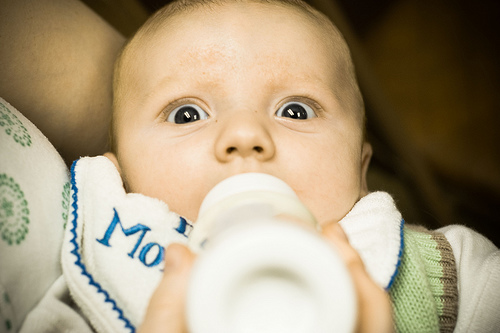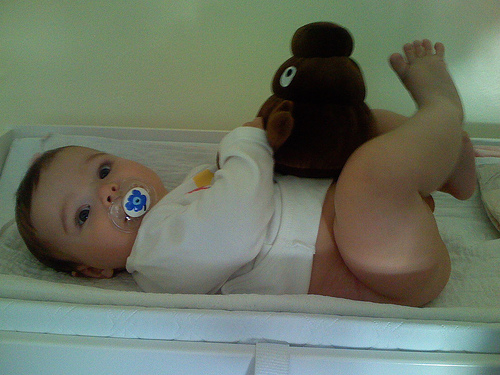How to Detect Lactose Intolerance in Babies

Being attentive to symptoms is the best way to detect lactose intolerance in babies. In this article we will share with you the symptoms that characterize this condition.
It is important to note that in young infants, acute diarrhea is the most common sign of intolerance. From the age of preschool and onwards, recurrent abdominal pain, abdominal distention and bloating start to become the cardinal symptoms.
According to Dr. Sylvia Cruchet intolerance is one of the main reasons that people consult gastroenterologists. She is a specialist in gastroenterology and pediatric nutrition.
Lactose intolerance is characterized by the presence of liquid stools, abdominal distention, gas, bloating, abdominal pain, intestinal colic and irritability.
In the case of infants or children under the age of 2, they can even start to present acidic depositions which cause excoriation of the anal region. These stools can have an acid odor or sometimes the odor of vinegar.
According to Cruchet, the most important factor is the occurrence of diarrhea in relation to the ingestion of lactose.
It is also important to study the relationship between suspending lactose and the disappearance of diarrhea.

What is lactose?
Lactose is the predominant sugar that is found in milk. According to experts in the field, the main cause of lactose intolerance is the inability of the intestine to digest it and transform it into its constituents (glucose and galactose).
This incapacity results from the shortage of an enzyme (protein) called lactase. Lactase production occurs in the small intestine.
A paper published by Dr. Cruchet states that 80% of the world population suffers from lactose intolerance to a greater or lesser degree. Many have symptoms that are reminiscent of irritable bowel syndrome.
She also points out that lactose intolerance is a type of adverse reaction food. Lactose intolerance is produced by a non-immune mechanism and it is 5-10 times more common than allergic reactions.
High levels of lactose
Lactose is present in the breast milk of all mammals from the end of pregnancy and it is present throughout lactation.
Lactose is the main source of carbohydrates for both premature and newborn babies. Breast milk contains around 7% lactose. 7% is a lot compared to other mammals. Cow milk for example, only contains 4% lactose.
Cow milk can be used as a substitute for breast milk if it is insufficient or absent.
There are different types of lactose intolerance:
- Congenital lactase deficiency
- Primary or late onset lactase deficiency
Congenital lactase deficiency is very rare and it is probably genetic. Its symptomatology begins at birth.
A symptom that can serve to identify this kind of intolerance is diarrhea that appears after the first moment in which an infant ingests breast milk. The same goes for cow milk or other products that contain lactose.
These children usually convey good health and have a healthy appetite, but soon dehydration and acidosis appear.
Failure to receive adequate treatment can lead to secondary malnutrition. According to Dr.Cruchet, stopping lactose intake results in rapid improvement of symptoms.
In contrast, primary or late onset lactase deficiency is due to the normal decrease of the enzyme lactate in the intestinal mucosa.
This kind of intolerance occurs after the child stops receiving breast milk. A high percentage of the human population suffers from it. The decrease of lactose often occurs in early life (between 1 and 3 years).
Lactose intolerance can occur more frequently in populations that live in environments with poor sanitary conditions. This occurs due to repeated gastrointestinal infections and malnutrition.

Diagnosing lactose intolerance
According to Dr. Sylvia Cruchet, lactose intolerance is most frequently diagnosed through the PH and reductive substances found in stool.
It is an affordable technique and it is available in most clinical services.
This diagnostic method is particularly useful with infants but it is less reliable during adulthood.
The choice test for lactose intolerance is the Hydrogen test in exhaled air. Children however must be old enough to blow through the test tube in order to carry out the test.
Being attentive to symptoms is the best way to detect lactose intolerance in babies. In this article we will share with you the symptoms that characterize this condition.
It is important to note that in young infants, acute diarrhea is the most common sign of intolerance. From the age of preschool and onwards, recurrent abdominal pain, abdominal distention and bloating start to become the cardinal symptoms.
According to Dr. Sylvia Cruchet intolerance is one of the main reasons that people consult gastroenterologists. She is a specialist in gastroenterology and pediatric nutrition.
Lactose intolerance is characterized by the presence of liquid stools, abdominal distention, gas, bloating, abdominal pain, intestinal colic and irritability.
In the case of infants or children under the age of 2, they can even start to present acidic depositions which cause excoriation of the anal region. These stools can have an acid odor or sometimes the odor of vinegar.
According to Cruchet, the most important factor is the occurrence of diarrhea in relation to the ingestion of lactose.
It is also important to study the relationship between suspending lactose and the disappearance of diarrhea.

What is lactose?
Lactose is the predominant sugar that is found in milk. According to experts in the field, the main cause of lactose intolerance is the inability of the intestine to digest it and transform it into its constituents (glucose and galactose).
This incapacity results from the shortage of an enzyme (protein) called lactase. Lactase production occurs in the small intestine.
A paper published by Dr. Cruchet states that 80% of the world population suffers from lactose intolerance to a greater or lesser degree. Many have symptoms that are reminiscent of irritable bowel syndrome.
She also points out that lactose intolerance is a type of adverse reaction food. Lactose intolerance is produced by a non-immune mechanism and it is 5-10 times more common than allergic reactions.
High levels of lactose
Lactose is present in the breast milk of all mammals from the end of pregnancy and it is present throughout lactation.
Lactose is the main source of carbohydrates for both premature and newborn babies. Breast milk contains around 7% lactose. 7% is a lot compared to other mammals. Cow milk for example, only contains 4% lactose.
Cow milk can be used as a substitute for breast milk if it is insufficient or absent.
There are different types of lactose intolerance:
- Congenital lactase deficiency
- Primary or late onset lactase deficiency
Congenital lactase deficiency is very rare and it is probably genetic. Its symptomatology begins at birth.
A symptom that can serve to identify this kind of intolerance is diarrhea that appears after the first moment in which an infant ingests breast milk. The same goes for cow milk or other products that contain lactose.
These children usually convey good health and have a healthy appetite, but soon dehydration and acidosis appear.
Failure to receive adequate treatment can lead to secondary malnutrition. According to Dr.Cruchet, stopping lactose intake results in rapid improvement of symptoms.
In contrast, primary or late onset lactase deficiency is due to the normal decrease of the enzyme lactate in the intestinal mucosa.
This kind of intolerance occurs after the child stops receiving breast milk. A high percentage of the human population suffers from it. The decrease of lactose often occurs in early life (between 1 and 3 years).
Lactose intolerance can occur more frequently in populations that live in environments with poor sanitary conditions. This occurs due to repeated gastrointestinal infections and malnutrition.

Diagnosing lactose intolerance
According to Dr. Sylvia Cruchet, lactose intolerance is most frequently diagnosed through the PH and reductive substances found in stool.
It is an affordable technique and it is available in most clinical services.
This diagnostic method is particularly useful with infants but it is less reliable during adulthood.
The choice test for lactose intolerance is the Hydrogen test in exhaled air. Children however must be old enough to blow through the test tube in order to carry out the test.
All cited sources were thoroughly reviewed by our team to ensure their quality, reliability, currency, and validity. The bibliography of this article was considered reliable and of academic or scientific accuracy.
- Infante, D. (2008, August). Intolerancia a la lactosa: en quién y por qué. In Anales de Pediatría (Vol. 69, No. 2, pp. 103-105). Elsevier Doyma.
- Larracilla-Alegre, J., García-Melgar, M., & Carranco, J. V. (2014). Intolerancia a la lactosa. Generalidades sobre el diagnóstico y tratamiento. Salud Pública de México, 26(2), 163-169. http://saludpublica.mx/index.php/spm/article/view/553
- La Orden Izquierdo, E., Carabaño Aguado, I., & Pelayo García, F. J. (2011). Situación actual de la intolerancia a la lactosa en la infancia. Pediatría Atención Primaria, 13(50), 271-278.
- Rodríguez Martínez, D., & Pérez Méndez, L. F. (2006). Intolerancia a la lactosa. Revista Española de Enfermedades Digestivas, 98(2), 143-143. http://scielo.isciii.es/pdf/diges/v98n2/paciente.pdf
This text is provided for informational purposes only and does not replace consultation with a professional. If in doubt, consult your specialist.








